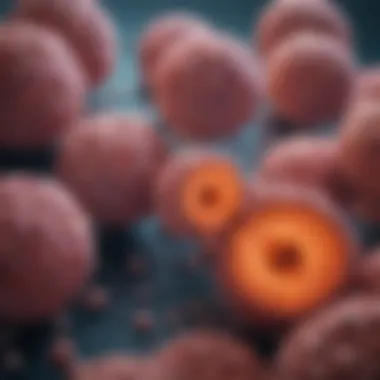Comprehensive Guide to Adenocarcinoma of the Colon


Intro
Adenocarcinoma of the colon presents significant challenges both in diagnosis and management. This type of cancer originates from the glandular epithelial cells within the colon, making it the most prevalent form of colorectal cancer. Understanding this condition is pivotal for various stakeholders, including researchers, medical professionals, and patients themselves. In this article, we will delve into the intricate details of adenocarcinoma, covering definitions, symptoms, treatment options, and implications for public health.
Overview of Research Topic
Brief Background and Context
Adenocarcinoma of the colon affects millions globally and is a leading cause of cancer-related deaths. Its development often begins with adenomatous polyps, benign growths that can progress to malignant tumors. According to recent statistics, the incidence of colorectal cancer has been increasing, especially among younger populations. This trend necessitates a comprehensive understanding of the disease, its risk factors, and potential interventions.
Importance in Current Scientific Landscape
Current research into adenocarcinoma focuses on genetic and environmental factors influencing its onset and progression. It emphasizes the importance of early detection and effective treatment modalities. Given the rising prevalence of this cancer subtype, the scientific community is intensively studying various approaches to diagnosis, treatment, and prevention through ongoing clinical trials and laboratory research.
Research Methodology
Research Design and Approach
The review of adenocarcinoma of the colon follows a systematic approach, synthesizing information from a variety of credible sources. Evidence from peer-reviewed journals, clinical studies, and meta-analyses helps to present a well-rounded perspective on the topic. By focusing on both quantitative and qualitative aspects, we aim to deliver insights that are data-driven and relevant to current clinical practices.
Data Collection Techniques
Data collection incorporates various methods, such as literature reviews, analysis of clinical case studies, and evaluation of existing databases on cancer registries. This mixed-method approach ensures that findings are comprehensive and applicable. The importance of utilizing apex databases, such as PubMed and cancer registries, cannot be overstated as they provide accessible and reliable data for researchers and practitioners alike.
Through this structured exploration, the article aspires to facilitate a deeper understanding of adenocarcinoma of the colon, equipping readers with essential knowledge for better engagement in both research and clinical practice.
Overview of Adenocarcinoma
Adenocarcinoma of the colon, as a significant subtype of colorectal cancer, warrants a detailed discussion. Understanding its characteristics provides crucial insights into early detection and effective treatment methods. The importance of this topic cannot be understated, as it forms the foundation for the subsequent sections of this article. This comprehensive review covers definitions, classifications, epidemiology, and the impacts of colon adenocarcinoma, emphasizing the need for awareness, early diagnosis, and research advancements.
Definition and Classification
Adenocarcinoma refers to cancer that originates from glandular cells. In the colon, this type of cancer arises from the mucous-secreting cells in the lining of the colon. The classification of colon adenocarcinoma is primarily divided into two main categories: well-differentiated and poorly differentiated. Well-differentiated adenocarcinomas closely resemble normal glandular tissues, which often indicates a better prognosis. In contrast, poorly differentiated adenocarcinomas have a more abnormal appearance and typically correlate with a worse outcome. Additional subtypes including mucinous and signet-ring cell adenocarcinomas also exist, with distinct histological features and clinical behaviors.
The classification system plays a vital role in determining treatment approaches and predicting outcomes.
Epidemiology of Colon Cancer
Colorectal cancer, particularly adenocarcinoma of the colon, has emerged as one of the leading causes of cancer-related mortality worldwide. According to recent statistics, the overall lifetime risk of developing colorectal cancer is approximately 1 in 24. Several factors influence this prevalence. Geographic variation is notable, with higher incidence rates reported in developed countries compared to developing regions.
Key points include:
- The average age of diagnosis is around 68 years, although increasing cases in younger populations have been noted.
- Men are generally at a higher risk than women, although this gap is narrowing.
- Lifestyle factors such as diet, obesity, physical inactivity, and smoking contribute significantly to risk.
- Family history of colorectal cancer also plays a crucial role, underlining the importance of genetic counseling and screening in high-risk groups.
Understanding the epidemiology of colon adenocarcinoma aids in developing targeted prevention strategies and policies aimed at reducing incidence rates.
Specifics of Colon Adenocarcinoma
Understanding the specifics of colon adenocarcinoma is essential because it digs deeper into the characteristics of this cancer type. By comprehending the details, we can better analyze its behavior, treatment, and the implications for patients. Each aspect sheds light on how this malignancy develops and manifests, guiding medical practitioners in diagnosis and management.
Histopathology of Adenocarcinoma
Histopathology is the study of tissues affected by disease. In colon adenocarcinoma, the histopathological examination is key for accurate diagnosis and prognosis. This cancer typically arises from glandular epithelial cells, which are responsible for mucus secretion in the colon.
Microscopically, adenocarcinoma shows distinctive patterns that help pathologists classify the tumor. Tumors can be differentiated based on their grade, which points to how abnormal the cells appear. Well-differentiated tumors look more like normal tissue, while poorly differentiated tumors often indicate a more aggressive behavior. Important characteristics include:
- Gland formation: Staining and special techniques help visualize the gland-like structures characteristic of adenocarcinomas.
- Invasive properties: Tumors infiltrate surrounding tissues, affecting diagnosis and treatment approaches.
- **Presence of mucin production: This is a notable feature, as increased mucus secretion can indicate specific tumor types.
The histopathological analysis is crucial not just for identifying the adenocarcinoma but also for choosing the right treatment strategy. Proper understanding of the cellular makeup can lead to better patient outcomes by informing surgical and chemotherapeutic choices.
Staging of Colon Adenocarcinoma


Staging is an essential aspect of cancer management. In colon adenocarcinoma, the most widely used system is the AJCC (American Joint Committee on Cancer) staging system. This system categorizes cancer based on tumor size, lymph node involvement, and metastasis status.
The stages are defined as follows:
- Stage 0: Carcinoma in situ, where cells are present but have not invaded deeper tissues.
- Stage I: Localized adenocarcinoma confined to the inner layers of the colon.
- Stage II: Tumor has grown into the muscular layers or surrounding tissues but has not spread to lymph nodes.
- Stage III: Cancer involves local lymph nodes but is still regional (not metastatic).
- Stage IV: Distant spread, often to the liver or lungs.
Staging is essential for treatment decisions. A localized tumor may be treated effectively with surgery alone, while advanced stages may require a combination of surgical intervention and additional therapies like chemotherapy or targeted therapy. Staging directly correlates with prognosis; earlier stages generally have better outcomes, while late-stage adenocarcinoma presents higher challenges.
The significance of accurate staging cannot be overstated. It not only affects treatment choices but also provides insights into survival outcomes, which are crucial for patients and their families.
Causes and Risk Factors
Understanding the causes and risk factors of adenocarcinoma of the colon is crucial for both prevention and early detection. Knowing these elements can provide individuals and healthcare professionals with insights into who may be more susceptible to this type of cancer. Identifying genetic, environmental, and lifestyle elements helps in tailoring prevention strategies and screening programs. This knowledge can enhance public health initiatives aimed at reducing incidence and improving outcomes for those affected.
Genetic Factors
Genetics plays a significant role in the development of colon adenocarcinoma. Certain hereditary syndromes increase the risk of developing this cancer. For instance, Familial Adenomatous Polyposis (FAP) is a genetic condition that causes hundreds of polyps in the colon, significantly raising an individual’s risk of colon cancer. Likewise, Lynch Syndrome, or hereditary nonpolyposis colorectal cancer (HNPCC), is associated with a higher risk of colorectal and other cancers.
Another aspect of genetic risk involves specific mutations in genes that affect cell growth and repair. The mutation of genes like APC, ML, and MS is linked to an increased likelihood of developing adenocarcinoma. Genetic testing can help individuals understand their risk and make informed decisions about screening and preventive measures. Understanding these factors is essential for family health histories and can influence medical recommendations.
Environmental Factors
Environmental elements can also contribute to the development of colon adenocarcinoma. Factors like exposure to carcinogens in the workplace, or the consumption of processed meats and high-fat diets have been studied intensively. Various studies suggest that consuming a diet high in red and processed meats can lead to increased risk. The World Health Organization has even classified processed meat as a Group 1 carcinogen.
Moreover, the role of inflammatory bowel disease (IBD), which includes conditions such as Ulcerative Colitis and Crohn's Disease, cannot be overlooked. These conditions cause chronic inflammation, increasing the risk of cancer in the colon over time. Understanding environmental influences can aid in public health strategies to limit exposure and promote healthier dietary choices.
Lifestyle Factors
Lifestyle choices are integral to assessing the risk of adenocarcinoma of the colon. Factors such as obesity, physical inactivity, and smoking significantly contribute to increased cancer risk. Studies link obesity with a higher risk of several cancers, including colon cancer.
Physical inactivity is another modifiable risk factor closely associated with this cancer. Regular exercise is shown to reduce the risk by improving gut health and promoting overall well-being. Additionally, engaging in consistent physical activity aids in maintaining a healthy weight, further decreasing risk.
Smoking, a well-known contributor to numerous cancers, also plays a role in the development of colon cancer. The toxins found in tobacco have been associated with mutations in cells that may lead to cancer over time.
- Regular exercise
- Healthy weight management
- Avoiding tobacco use
These are fundamental lifestyle changes that can lower the risk of colon adenocarcinoma. Being aware of lifestyle factors helps individuals take proactive steps toward reducing their overall cancer risk.
Symptoms and Diagnosis
Common Symptoms of Adenocarcinoma
Adenocarcinoma of the colon can present various symptoms. Some of the most common symptoms include:
- Abdominal Pain: This can range from mild discomfort to severe pain.
- Changes in Bowel Habits: Patients might experience diarrhea or constipation often, or a change in the consistency of their stool.
- Blood in Stool: This may be noticed as bright red blood or dark, tar-like stools.
- Unexplained Weight Loss: Patients might lose weight without trying.
- Fatigue: Ongoing tiredness not relieved by rest is another symptom.
Recognizing these symptoms is paramount, as early detection can lead to better management options. However, these symptoms can also overlap with other gastrointestinal disorders, making clinical evaluation vital.
Diagnostic Procedures
Diagnosing adenocarcinoma of the colon generally involves a combination of medical history evaluation, physical examinations, and laboratory tests. Key diagnostic procedures include:
- Colonoscopy: This procedure allows doctors to visually examine the colon and rectum using a flexible tube with a camera. It is the primary method for detecting polyps and tumors.
- Biopsies: If irregularities are detected during a colonoscopy, small tissue samples may be collected for histopathological analysis.
- Blood Tests: Blood tests, including complete blood counts and tumor markers such as Carcinoembryonic antigen (CEA), can provide additional information.
These diagnostics play a crucial role in confirming the presence of adenocarcinoma and staging the disease, which is vital for planning treatment.
Imaging Techniques and Biopsies
Imaging techniques further aid in diagnosing adenocarcinoma and determining its extent. Common imaging methods include:
- CT Scan: This imaging technique provides detailed cross-sectional images of the colon and surrounding organs, helping to assess the cancer's spread.
- MRI: Magnetic resonance imaging can be useful in evaluating the local invasion of the tumor into surrounding tissues.
- Ultrasound: Although not typically used alone, ultrasound can help determine the presence of masses.


In cases where cancer is suspected, biopsies remain a definitive method for diagnosis. The pathologist analyzes the tissue samples to look for cancerous cells and determine the nature of the adenocarcinoma.
Early diagnosis is directly linked to improved survival rates for patients with colorectal cancer.
In summary, understanding symptoms and diagnosis of adenocarcinoma of the colon is essential. It allows individuals to seek timely medical assistance and enables healthcare professionals to employ effective diagnostic measures. An informed approach can enhance patient outcomes and ensure that necessary interventions are initiated promptly.
Treatment Options for Colon Adenocarcinoma
The treatment landscape for colon adenocarcinoma is expansive and continually evolving. This section emphasizes the importance of understanding various treatment modalities, as they play a critical role in managing the disease effectively. The approaches discussed underscore not only the medical strategies available but also the need for personalized treatment based on individual patient circumstances. Awareness of these options can significantly impact both survival rates and quality of life for patients diagnosed with this form of cancer.
Surgical Interventions
Surgery remains the cornerstone of treatment for colon adenocarcinoma, particularly in the early stages. The most common type of surgical procedure is a colectomy, which involves removing the tumor along with a margin of healthy tissue. The extent of surgery may vary:
- Partial Colectomy: Removal of the section of the colon containing the tumor.
- Total Colectomy: Complete removal of the colon, possibly followed by ileostomy.
- Laparoscopic Surgery: Minimally invasive techniques may also be employed, offering faster recovery times.
Choosing to undergo surgery is a significant decision, often dependent on tumor size, location, and overall patient health. Many patients benefit from preoperative assessments which help clarify the best surgical plan. Post-surgery, careful monitoring is necessary to detect any recurrence.
Chemotherapy and Radiation Therapy
Chemotherapy plays a pivotal role in the management of colon adenocarcinoma, particularly when the cancer is diagnosed at a later stage or has spread to lymph nodes. Chemotherapy uses drugs to target and kill cancer cells, and it can be administered in several regimens:
- Adjuvant Chemotherapy: Given after surgery to eradicate residual cancer cells.
- Neoadjuvant Chemotherapy: Used prior to surgery to shrink tumors.
Radiation therapy is less common for colon cancer but can be effective in specific cases, particularly for rectal adenocarcinoma. It uses high-energy particles to destroy cancer cells or inhibit their growth. It's often combined with chemotherapy to enhance the overall effectiveness. The choice between these therapies depends on factors like tumor location and spread of the disease.
According to studies, combining chemotherapy with other treatments can significantly improve patient outcomes and survival chances.
Targeted Therapy and Immunotherapy
Targeted therapy and immunotherapy represent the forefront of cancer treatment innovations. These approaches focus on specific characteristics of cancer cells:
- Targeted Therapy: This includes medications that specifically target pathways critical for cancer cell survival and growth. Commonly used agents include cetuximab and bevacizumab.
- Immunotherapy: This approach enhances the body's immune response against tumor cells. It is particularly beneficial for patients with specific genetic markers, such as microsatellite instability. Pembrolizumab is an example of an immunotherapeutic agent used in certain cases of colon adenocarcinoma.
Incorporating these therapies into treatment plans is creating new possibilities for enhanced efficacy. It is essential for oncologists to evaluate the genetic makeup of tumors to identify the most appropriate treatment strategies, potentially leading to better outcomes for patients.
Prognosis and Outcomes
The prognosis of adenocarcinoma of the colon is a critical aspect in understanding the overall impact of the disease. It provides insight into the likely course and outcome based on various clinical and pathological factors. The prognosis directly informs patients, families, and healthcare providers about potential outcomes, helping guide treatment decisions and future care planning.
In clinical practice, evaluating the prognosis involves understanding factors that can influence the survival rate. These include tumor stage at diagnosis, tumor grade, the presence of metastasis, and specific histological features. Moreover, the patient's overall health, age, and response to treatment also play significant roles. By understanding survival rates and associated factors, patients can make informed decisions about their care.
Key benefits of understanding prognosis are:
- Informed Decision-making: Patients gain valuable insights that enable them to engage in discussions about treatment options.
- Personalized Care: Healthcare providers can tailor interventions to align with the expected outcomes based on individual patient profiles.
- Psychological Preparedness: Patients and families can prepare for possible challenges related to the disease and treatment.
Survival Rates and Factors
Survival rates for adenocarcinoma of the colon can vary noticeably based on several factors. Statistical analyses typically provide a five-year survival rate as a measure of prognosis. According to various studies, the five-year survival rate for localized colon adenocarcinoma can be as high as 90% if detected early. However, in advanced stages with distant metastasis, the rate may drop to about 15%.
Several factors can influence survival rates:
- Tumor Stage: Early-stage diagnoses tend to have better outcomes than those detected at later stages.
- Lymph Node Involvement: The presence of cancer in regional lymph nodes is a significant predictor of reduced survival.
- Tumor Location: Cancers originating in different parts of the colon may have different prognoses.
- Histological Grade: Poorly differentiated tumors generally respond less favorably to treatment compared to well-differentiated ones.
"Survival rates are not definitive predictors for every individual; they represent statistical trends based on previous cases."
Common Complications
Understanding the complications associated with adenocarcinoma of the colon is pivotal for comprehensive patient care. Complications may arise from both the cancer itself and the treatments employed to manage it. Some of the noticeable complications include:
- Bowel Obstruction: Tumors may grow large enough to block the intestines, leading to severe discomfort and requiring surgical intervention.
- Perforation: Advanced tumors can cause a perforation in the colon, which is a medical emergency due to the risk of infection.
- Metastasis: The cancer may spread to other organs, complicating treatment and worsening prognosis.
- Side Effects of Treatment: Chemotherapy and radiation can lead to issues such as fatigue, nausea, and increased risk of infections.
- Psychological Impact: Many patients may experience anxiety or depression related to their diagnosis, which can hinder their overall well-being and treatment adherence.


Awareness and management of these complications are vital in optimizing outcomes and improving quality of life for patients with adenocarcinoma.
Preventative Measures and Screening
Preventative measures and screening play a crucial role in managing colon adenocarcinoma. Early detection can lead to better outcomes and lower mortality rates. Knowing the risk factors and potential symptoms is essential, but proactive measures can help in preventing the disease altogether. Understanding the importance of screening programs and lifestyle modifications is critical for individuals and healthcare providers alike.
Role of Screening Programs
Screening programs serve as an effective means for early detection of colon adenocarcinoma. They help identify precancerous lesions before they can develop into cancer. Regular screening can significantly decrease cancer-related mortality.
Common screening methods include:
- Colonoscopy: This is the gold standard for detecting abnormalities in the colon. It allows for direct visualization of the lining and the possibility to remove polyps simultaneously.
- Fecal Occult Blood Tests: These tests detect hidden blood in the stool, which may indicate the presence of polyps or cancer.
- Sigmoidoscopy: This procedure examines only the lower part of the colon, but it can still identify certain problems.
The United States Preventive Services Task Force recommends that screening begin at age 45 for average-risk individuals. People with a family history of colon cancer or certain genetic syndromes may need to begin screening earlier.
"Proactive screening can catch the development of adenocarcinoma at its earliest stages, where treatment is most effective."
Dietary and Lifestyle Modifications
Lifestyle choices can have a profound effect on the risk of developing colon adenocarcinoma. Adjusting diet and activity levels may contribute to reducing risk factors associated with the disease.
Key dietary modifications include:
- Increased fiber intake: Consuming fruits, vegetables, and whole grains can improve bowel health.
- Reduced red and processed meat intake: Studies suggest a link between high consumption of these foods and an increased risk of colorectal cancer.
- Adopting a Mediterranean diet: This diet focuses on healthy fats, lean proteins, and plenty of fruits and vegetables.
In addition to dietary changes, maintaining a healthy lifestyle is also vital:
- Regular physical activity: Aim for at least 150 minutes of moderate exercise weekly.
- Maintaining a healthy weight: Obesity is a significant risk factor for colon cancer.
- Avoiding tobacco and limiting alcohol consumption: Both behaviors can increase the risk of many types of cancer, including colon adenocarcinoma.
Current Research and Future Directions
Research on adenocarcinoma of the colon is crucial in understanding this widespread disease. Ongoing investigations focus on enhancing treatment efficacy and improving survival outcomes. Novel therapeutic approaches and strategies are being explored to address this form of cancer. These developments have potential to revolutionise patient care.
Emerging Treatments
Emerging treatments for colon adenocarcinoma include new drug formulations and therapeutic combinations. Targeted therapies are gaining attention, as they directly affect the cancer's cellular mechanisms. This approach minimizes damage to surrounding healthy tissues. Many studies are examining the effectiveness of medications like Regorafenib and Capecitabine. Clinical trials are essential for determining optimal treatment regimens.
Immunotherapy is another focus area. It leverages the body’s immune system to attack cancer cells. Pembrolizumab, for instance, has shown promise in specific cases of colorectal cancer.
"Innovative treatments are crucial to improving outcomes in colorectal cancer."
Biomarkers are also being assessed for their ability to guide treatment choices. Research is delving into how these markers predict responses to various therapies. This understanding could lead to more personalised approaches, targeting treatment based on an individual’s cancer characteristics.
Genetic Research and Personalized Medicine
Genetic research is advancing our comprehension of adenocarcinoma. Identifying genetic mutations related to this cancer type allows for tailored treatment options. Studies focus on mutations in the KRAS, NRAS, and BRAF genes. These alterations can influence both prognosis and therapeutic approaches.
Personalized medicine aims to provide specific treatments based on a patient’s genetic profile. This method enables oncologists to select therapies with greater likelihood of effectiveness for each individual. As research progresses, there is an increase in genetic-testing availability for patients.
Additionally, understanding genetic predispositions helps identify high-risk populations. Regular screening can lead to earlier interventions, improving survival rates.
Research continues to evolve, enhancing our knowledge and approaches to combat this disease. Collaboration among scientists, clinicians, and patients will be vital in refining and implementing these innovations effectively.
The End
In discussing adenocarcinoma of the colon, it is crucial to summarize key aspects and their significance in promoting awareness of this common yet serious condition. This conclusion addresses the importance of the article's findings. Understanding adenocarcinoma is vital for medical professionals, researchers, and the general public, as it helps in recognizing symptoms, identifying risk factors, and comprehending treatment options.
Summation of Key Points
- Adenocarcinoma is the most prevalent type of colorectal cancer, arising from the glandular cells in the colon.
- The article explored the definition and classification of this cancer, outlining its types and mechanisms.
- Epidemiological data indicates an increasing incidence, stressing the need for effective screening.
- Causes range from genetic mutations to environmental exposures and lifestyle choices, offering pathways for preventative measures.
- Diagnosis involves a combination of symptom recognition, imaging techniques, and biopsies to confirm malignancy.
- Treatment options include surgery, chemotherapy, radiation therapy, and advancements in targeted therapies.
- Prognosis varies according to staging at diagnosis, with early detection leading to significantly improved outcomes.
- Recent research indicates promising areas in emerging treatments and genetic exploration tailored to individual patient profiles.
Implications for Public Health
- Raising awareness about screening programs can lead to earlier detection and better survival rates.
- Public health campaigns focusing on lifestyle modifications, such as diet and exercise, can reduce incidence rates.
- Emphasizing genetic counseling and testing may assist at-risk individuals in making informed healthcare decisions.
- Continuous research funding is essential to develop novel treatments and improve existing therapeutic options.
"A comprehensive understanding of adenocarcinoma can lead to not just individual health benefits, but also broader societal improvement in managing colorectal cancer."



